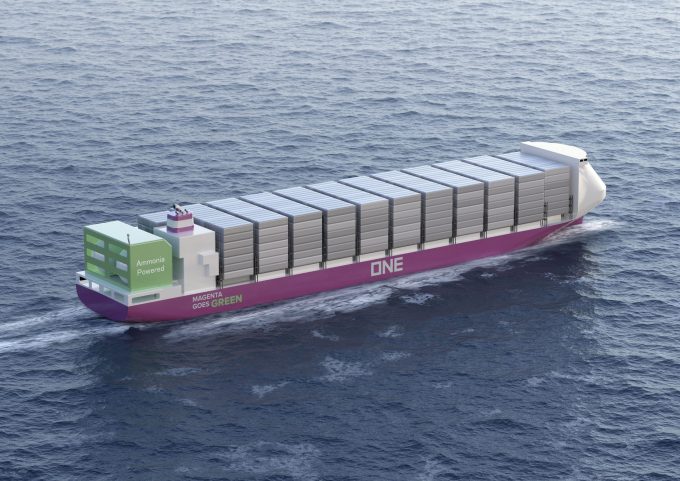HMM sees opportunities in Hapag-Lloyd’s exit from THE Alliance
HMM CEO Kim Kyung-Bae believes Hapag-Lloyd’s departure from THE Alliance will be a big opportunity ...

Ammonia, rivalling methanol in the next-generation fuels race, received a vote of confidence from Ocean Network Express (ONE) today with its approval-in-principle for a 3,500 teu ammonia-fuelled box ship.
Developed by ONE, Nihon Shipyard and classification society DNV, the vessel design features twin ‘type-B’ spherical ammonia tanks aft, apparently sacrificing around 320 teu of capacity.
Potential spillage is one of the main concerns over ammonia, one expert warning the fuel could “sterilise cubic miles of ocean” if it leaked into the sea.
It is plausible, therefore, that situating tanks in close proximity to the funnel and on deck, rather than below the waterline, would allow the fuel to be quickly flared off in the event of a sinking – though the reason for the location has yet to be confirmed by ONE.
According to DNV’s Ammonia as a Marine Fuel guidance, tanks must be located “…a minimum distance from ship sides and bottom to limit the risk of tank damage in a collision and grounding scenario”, and “away from engine rooms and other high fire-risk spaces… protected from crane operations or other mechanical damage risk areas”.
Like Maersk’s methanol-fuelled vessel designs, the ONE ship features a streamlined forecastle, with the bridge at the bow, despite the prevailing understanding among seafarers that this diminishes crew comfort and exacerbates seasickness.
A dichotomy between ammonia and the more recently fashionable methanol is thought to be what will characterise shipping’s efforts to reduce or eliminate carbon emissions from vessels in the coming decades.
Like methanol, ammonia’s effectiveness as a CO2-reduction measure will hinge on how it is manufactured: ‘green’ processes, based on renewable energy; the more dubious ‘blue’ method, involving fossil fuels with carbon capture; the controversial ‘pink’, using nuclear power; and ‘grey’, involving a process which emits more carbon than using fossil fuels.
One advantage of ammonia is that, unlike methanol, it will emit no CO2, only water vapour, at the funnel. But, complicating the situation further, water vapour is also a greenhouse gas.
Koshiro Wake, SVP of corporate strategy and sustainability at ONE, said: “Ammonia is definitely one of the primary focuses of our research, as ammonia fuel has a great potential of generating lower GHG emissions than conventional marine fuels.”
Comment on this article